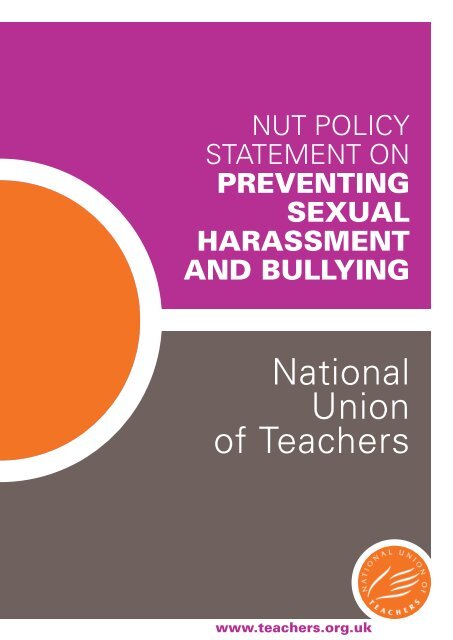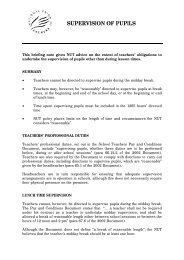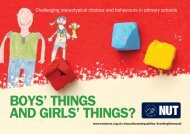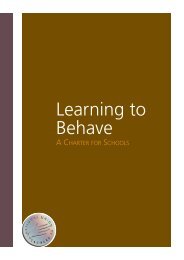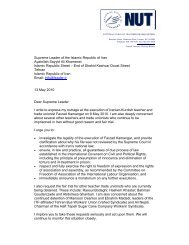NUT policy statement on preventing sexual harassment and bullying
NUT policy statement on preventing sexual harassment and bullying
NUT policy statement on preventing sexual harassment and bullying
Create successful ePaper yourself
Turn your PDF publications into a flip-book with our unique Google optimized e-Paper software.
<str<strong>on</strong>g>NUT</str<strong>on</strong>g> POLICY<br />
STATEMENT ON<br />
PREVENTING<br />
SEXUAL<br />
HARASSMENT<br />
AND BULLYING<br />
Nati<strong>on</strong>al<br />
Uni<strong>on</strong><br />
of Teachers<br />
www.teachers.org.uk
<str<strong>on</strong>g>NUT</str<strong>on</strong>g> POLICY STATEMENT ON PREVENTING<br />
SEXUAL HARASSMENT AND BULLYING<br />
PREFACE<br />
The past ten years have witnessed a growing awareness <strong>and</strong> an increase in research into<br />
<strong>bullying</strong> in schools. Bullying is now recognised as <strong>on</strong>e of the most destructive social<br />
processes that young people can experience in schools, <strong>and</strong> <strong>on</strong>e of the most difficult<br />
challenges for teachers to tackle.<br />
Yet the research literature <strong>on</strong> <strong>bullying</strong>, <strong>and</strong> the Government’s educati<strong>on</strong> <str<strong>on</strong>g>policy</str<strong>on</strong>g>, fail to engage<br />
with what we know about schools from expert researchers c<strong>on</strong>cerned with gender, race,<br />
<strong>and</strong> <strong>sexual</strong> orientati<strong>on</strong>.<br />
Many school policies <strong>on</strong> <strong>bullying</strong> make no reference to gender based or <strong>sexual</strong>ised <strong>bullying</strong>.<br />
Sexual violence <strong>and</strong> <strong>harassment</strong> are often absent in definiti<strong>on</strong>s of ‘<strong>bullying</strong>’. For this reas<strong>on</strong>,<br />
the Nati<strong>on</strong>al Uni<strong>on</strong> of Teachers asked teachers, throughout 2006, to share their experiences<br />
of sexism, <strong>sexual</strong>/sexist <strong>bullying</strong> <strong>and</strong> <strong>sexual</strong> <strong>harassment</strong>.<br />
This <str<strong>on</strong>g>policy</str<strong>on</strong>g> <str<strong>on</strong>g>statement</str<strong>on</strong>g> is the result of the feedback from several hundred teachers. They<br />
identified that more acti<strong>on</strong> was needed by local authorities, school leaders <strong>and</strong> the Uni<strong>on</strong>.<br />
Women teachers specifically asked for advice <strong>on</strong> how to challenge sexist attitudes <strong>and</strong><br />
<strong>sexual</strong>ised violence.<br />
Sexual <strong>bullying</strong>, taken in this c<strong>on</strong>text to mean a wide range of pupil behaviour extending<br />
from name calling to physical <strong>sexual</strong> assault, undermines the dignity <strong>and</strong> safety of girls <strong>and</strong><br />
women learning <strong>and</strong> teaching in our schools. The instituti<strong>on</strong>al pressures <strong>on</strong> young boys to be<br />
stereotypically ‘masculine’ dem<strong>and</strong> that young men learn to express their ‘masculinity’ by<br />
devaluing all things feminine. If they do not, they are very likely to fall prey to sexist <strong>and</strong><br />
homophobic <strong>bullying</strong>.<br />
Supporting schools in <strong>preventing</strong> the attitudes about men <strong>and</strong> women which generate<br />
<strong>sexual</strong> <strong>harassment</strong> is a high priority for the Nati<strong>on</strong>al Uni<strong>on</strong> of Teachers. There is much more<br />
to be learned about how <strong>sexual</strong> <strong>bullying</strong> undermines the learning opportunities <strong>and</strong><br />
emoti<strong>on</strong>al health of all young people, <strong>and</strong> about which strategies work in practice.<br />
We have an opportunity for change right now in the shape of the Equality Act 2006: the<br />
greatest shake up in sex equality laws since 1975. This is an exciting time for equality <strong>and</strong><br />
the <str<strong>on</strong>g>NUT</str<strong>on</strong>g> welcomes the new gender equality duty as a powerful tool that can deliver real<br />
change. As part of that change, I hope that this <str<strong>on</strong>g>statement</str<strong>on</strong>g> will raise awareness of the issues<br />
which lie at the heart of much <strong>bullying</strong> of children, young people <strong>and</strong> teachers.<br />
Steve Sinnott<br />
General Secretary<br />
3
SEXUAL LANGUAGE AND SEXUAL BULLYING<br />
1. Many children <strong>and</strong> young people in primary <strong>and</strong> sec<strong>on</strong>dary schools experience <strong>sexual</strong><br />
<strong>bullying</strong>, in some schools <strong>on</strong> a daily basis. 1<br />
2. Sexual <strong>harassment</strong> <strong>and</strong> <strong>sexual</strong> <strong>bullying</strong> is most often carried out by boys against girls.<br />
<str<strong>on</strong>g>NUT</str<strong>on</strong>g> survey evidence suggests, however, that increasingly girls are also directing<br />
<strong>sexual</strong> abuse at other girls <strong>and</strong> boys. This language is increasingly used in some primary<br />
schools: pupils do not always know what it means or that the terms they are using are<br />
derogatory to women.<br />
3. Sexual language <strong>and</strong> <strong>sexual</strong> <strong>bullying</strong> can include explicit <strong>sexual</strong> remarks, display of<br />
<strong>sexual</strong> material, <strong>sexual</strong> gestures, unwanted physical attenti<strong>on</strong>, comments about <strong>sexual</strong><br />
reputati<strong>on</strong> or performance or inappropriate touching.<br />
4. Research c<strong>on</strong>cludes that girls have little faith in the effectiveness of school behaviour<br />
systems in tackling <strong>sexual</strong> <strong>bullying</strong>. This is compounded if the girl is not white.<br />
5. The experience of <strong>bullying</strong> is not c<strong>on</strong>fined to children <strong>and</strong> young people. Teachers <strong>and</strong><br />
other school staff can experience <strong>bullying</strong> by other teachers <strong>and</strong> by young people<br />
themselves. Sometimes, this can take the form of <strong>sexual</strong> <strong>bullying</strong>; evidence of which<br />
was revealed by an <str<strong>on</strong>g>NUT</str<strong>on</strong>g> survey of teachers.<br />
6. All forms of <strong>bullying</strong> are unacceptable, whether between children, between adults, or<br />
between children <strong>and</strong> adults. This <str<strong>on</strong>g>policy</str<strong>on</strong>g> <str<strong>on</strong>g>statement</str<strong>on</strong>g> sets out the evidence <strong>on</strong> <strong>bullying</strong> in<br />
schools <strong>and</strong> describes the issues that need to be tackled. It summarises the legislative<br />
requirements <strong>and</strong> advice available in Engl<strong>and</strong> <strong>and</strong> in Wales which can support teachers<br />
in tackling <strong>sexual</strong> <strong>bullying</strong>.<br />
Girls’ <strong>and</strong> boys’ experiences of <strong>sexual</strong> <strong>bullying</strong><br />
7. Research 2 shows that the range of <strong>sexual</strong> <strong>bullying</strong> practices endured by girls is similar<br />
to that of boys, but that clearer forms of <strong>sexual</strong> <strong>harassment</strong> are evident in schools<br />
against girls – particularly boys making frequent unwanted <strong>sexual</strong> remarks or physical<br />
moves against them. Where boys fear being called ‘gay’, girls are censored by being<br />
called ‘slag’. The language of girl <strong>on</strong> girl assaults is also overtly <strong>sexual</strong>, however, with<br />
girls comm<strong>on</strong>ly referring to <strong>on</strong>e another’s <strong>sexual</strong> character or <strong>sexual</strong> appearance.<br />
8. Research in primary schools shows that <strong>sexual</strong> <strong>harassment</strong> starts in this phase. This<br />
comm<strong>on</strong>ly takes the form of boys denigrating girls <strong>and</strong> women through <strong>sexual</strong>ly<br />
abusive <strong>and</strong> aggressive language. An <str<strong>on</strong>g>NUT</str<strong>on</strong>g> study 3 shows that verbal insults<br />
predominantly centred around girls’ <strong>sexual</strong> status including terms such as ‘bitch’, ‘slag’,<br />
‘tart’ <strong>and</strong> ‘slut’. Other researchers cite similar evidence 4 . Alarmingly, these incidents are<br />
typically dismissed as playful behaviour or justified through humour.<br />
9. Various sec<strong>on</strong>dary school studies document the pervasiveness of <strong>sexual</strong> <strong>harassment</strong><br />
experienced by girls <strong>and</strong> young women in sec<strong>on</strong>dary schools.<br />
1<br />
Presumed Innocence: Hetero<strong>sexual</strong> heterosexist <strong>and</strong> homophobic <strong>harassment</strong> am<strong>on</strong>g primary ages school girls <strong>and</strong> boys,<br />
Emma Renold, Cardiff University, Childhood, 2002<br />
2<br />
Sexual Bullying: Gender C<strong>on</strong>flict <strong>and</strong> Pupil Culture in Sec<strong>on</strong>dary schools, Neil Duncan, Routledge,1999<br />
3<br />
A Serious Business: <str<strong>on</strong>g>NUT</str<strong>on</strong>g> survey of teachers’ experiences of sexism <strong>and</strong> <strong>harassment</strong> in schools <strong>and</strong> colleges, Sean Neill,<br />
University of Warwick, 2006<br />
4<br />
The Great Divide: Gender in the primary school, M Clark, 1990<br />
4
10. Boys are also subjected to a range of <strong>sexual</strong> <strong>bullying</strong> by other boys <strong>and</strong> by girls. They<br />
also experience less obvious forms of attack. The most prevalent issue is <strong>sexual</strong> verbal<br />
abuse <strong>and</strong> being casually called obscene names. Names which cause most offence to<br />
boys are homophobic terms, associated with the ‘absence’ of high status masculinity. 5<br />
SEXISM AND SEXIST ATTITUDES<br />
11. As well as being ‘<strong>sexual</strong>’ the language <strong>and</strong> behaviour directed by pupils to each other,<br />
<strong>and</strong> directed at staff, is often sexist. Attitudes <strong>and</strong> behaviour, as well as language, can<br />
be sexist.<br />
12. Sexism is behaviour, language or prejudice which expresses instituti<strong>on</strong>alised,<br />
systematic <strong>and</strong> comprehensive discriminati<strong>on</strong>. It is based <strong>on</strong> a stereotypical view of<br />
masculine <strong>and</strong> feminine roles. Sexism limits the opti<strong>on</strong>s of women <strong>and</strong> girls <strong>and</strong> can<br />
lead to discriminati<strong>on</strong> or less favourable treatment. It is learned behaviour, however,<br />
<strong>and</strong> can therefore be ‘unlearned’.<br />
Sexist stereotypes as a cause of <strong>bullying</strong><br />
13. In the last 30 years, c<strong>on</strong>siderable progress has been made in schools towards<br />
underst<strong>and</strong>ing barriers to equality between boys <strong>and</strong> girls. Development of equal<br />
opportunities policies, <strong>and</strong> a greater knowledge of how children engage with learning,<br />
have provided the opportunity for schools to challenge stereotypes <strong>and</strong> prejudice.<br />
There are some stereotypes, however, that remain almost impervious to change <strong>and</strong><br />
c<strong>on</strong>tinue to have a profound impact.<br />
14. Outdated noti<strong>on</strong>s persist about the differences between girls <strong>and</strong> boys which lead to<br />
expectati<strong>on</strong>s of different outcomes, achievements <strong>and</strong> behaviours based <strong>on</strong> their sex.<br />
These noti<strong>on</strong>s limit all young people. Stereotypes put pressure <strong>on</strong> boys <strong>and</strong> girls to<br />
c<strong>on</strong>form to certain noti<strong>on</strong>s of ‘masculinity’ <strong>and</strong> ‘femininity’. They are a cause of <strong>bullying</strong>.<br />
15. Often, girls feel they have to decide how far to engage with, or reject, ‘girlie’<br />
characteristics. Yet, generally, girls do not have the skills to enable them to resist the<br />
pressures to c<strong>on</strong>form. Boys feel pressurised to commit to dominant forms of<br />
masculinity – in order to attain popularity <strong>and</strong> escape censure. These expected forms of<br />
masculinity include various combinati<strong>on</strong>s of football, fighting, girlfriends, sex, anti-gay<br />
talk <strong>and</strong> misogyny.<br />
Links between sexism <strong>and</strong> homophobia<br />
16. Most researchers c<strong>on</strong>clude that boys use ‘sex talk’, <strong>sexual</strong> story-telling, public <strong>sexual</strong><br />
innuendoes <strong>and</strong> the objectificati<strong>on</strong> of girls to publicly validate their masculinity to their<br />
friends, <strong>and</strong> validate their masculinity to other girls in the class. 6<br />
17. Girls <strong>and</strong> boys who actively resist stereotypical masculinities <strong>and</strong> femininities are often<br />
targeted by their peers. Research 7 shows that young people who fail to c<strong>on</strong>form to<br />
‘normal’ forms of age appropriate gender behaviour are teased, socially excluded <strong>and</strong><br />
humiliated by peers, through name-calling, often to a degree to which teachers are<br />
unaware because it is not reported.<br />
5<br />
Sexual Bullying: Gender C<strong>on</strong>flict <strong>and</strong> Pupil Culture in Sec<strong>on</strong>dary Schools., Neil Duncan, Routledge, 1999<br />
6<br />
The Making of Men: Masculinities, <strong>sexual</strong>ities <strong>and</strong> schooling, Mac <strong>on</strong> Ghaill M, Buckingham, Open University Press, 1994<br />
7<br />
‘They w<strong>on</strong>t let us play…unless you’re going out with them’ E Renold, BJSE, Vol 27, No 4, Sept 2006<br />
5
18. Failure for children to c<strong>on</strong>form to expected gender/<strong>sexual</strong> traits can result in sexist<br />
(e.g., ‘sissy’, ‘girl’), or <strong>sexual</strong> (‘tart’, ‘slag’) <strong>and</strong>/or homophobic (‘queer’, ‘poof’, ‘lezzie’)<br />
name-calling <strong>and</strong> social exclusi<strong>on</strong>. Those young people who systematically fail to<br />
c<strong>on</strong>form to stereotypical expectati<strong>on</strong>s are subjected to the most sustained forms of<br />
sexist <strong>bullying</strong> <strong>and</strong> <strong>sexual</strong>ised <strong>harassment</strong>. 8<br />
19. Society pressurises boys into defining their hetero<strong>sexual</strong>ity through various forms of<br />
behaviour such as treating girls as <strong>sexual</strong> objects <strong>and</strong> using homophobic taunts against<br />
other boys. Homophobic behaviour by boys in schools is as much about c<strong>on</strong>firming<br />
their gender as ‘real men’ as about <strong>sexual</strong>ity or <strong>sexual</strong> activity. It is important for<br />
teachers to appreciate that many of the anti-gay insults directed at boys are used to<br />
ridicule <strong>and</strong> punish behaviour which differs from recognisable ‘masculine’ traits, rather<br />
than to their perceived or actual <strong>sexual</strong> orientati<strong>on</strong>.<br />
DO TEACHERS EXPERIENCE SEXIST BULLYING AND<br />
SEXUAL HARASSMENT?<br />
20. Sexist <strong>and</strong> <strong>sexual</strong> language is comm<strong>on</strong> in some schools. Teachers experience various<br />
forms of unacceptable pupil behaviour during their careers <strong>and</strong> this can include sexist<br />
language, sexist <strong>bullying</strong>, <strong>sexual</strong> language or <strong>sexual</strong> <strong>harassment</strong>. Teachers may<br />
experience comments about their appearance; <strong>sexual</strong> remarks; <strong>sexual</strong> gestures;<br />
unwanted physical attenti<strong>on</strong>; inappropriate touching or be subject to sexist language<br />
<strong>and</strong> assumpti<strong>on</strong>s.<br />
21. An <str<strong>on</strong>g>NUT</str<strong>on</strong>g> study 9 carried out in 2006 revealed that two out of every five teachers (39 per<br />
cent) had encountered sexist language being directed by pupils to colleagues. Eleven<br />
per cent of the sample reported that they had experienced <strong>sexual</strong> <strong>harassment</strong> from<br />
pupils at some point in their careers <strong>and</strong> 8 per cent had experienced it in the last 12<br />
m<strong>on</strong>ths. The study showed that young female members experience disproporti<strong>on</strong>ately<br />
higher levels of <strong>sexual</strong> <strong>harassment</strong>.<br />
22. While teachers may experience this problem to a greater degree in some settings,<br />
<strong>sexual</strong> <strong>harassment</strong> can happen in any school, large or small, rural or urban, special or<br />
mainstream. Making a complaint, however, of <strong>sexual</strong> <strong>harassment</strong> or challenging <strong>sexual</strong><br />
terms used comm<strong>on</strong>ly in the classroom can be difficult for teachers. The <str<strong>on</strong>g>NUT</str<strong>on</strong>g>’s study<br />
showed that many teachers had tolerated behaviour they found offensive.<br />
23. Some teachers lacked c<strong>on</strong>fidence that school leaders would take complaints seriously.<br />
They feared also that their capability or competence would be questi<strong>on</strong>ed if they<br />
reported challenging pupil behaviour. The <str<strong>on</strong>g>NUT</str<strong>on</strong>g> study revealed that teachers did not<br />
report incidents because their school or college took no acti<strong>on</strong> to c<strong>on</strong>fr<strong>on</strong>t sexist<br />
language. Teachers sometimes felt powerless <strong>and</strong> did not have c<strong>on</strong>fidence in the<br />
reporting system.<br />
8<br />
Schooling Innocence: Young children, gender <strong>and</strong> <strong>sexual</strong>ity, E Renold<br />
9<br />
A Serious Business: <str<strong>on</strong>g>NUT</str<strong>on</strong>g> survey of teachers’ experiences in <strong>and</strong> outside the classroom of sexism, <strong>sexual</strong> <strong>harassment</strong> <strong>and</strong><br />
<strong>sexual</strong> assault in schools <strong>and</strong> colleges, Sean Neill, University of Warwick, 2006<br />
6
24. Teachers reported that unc<strong>on</strong>scious sexism needed to be tackled.<br />
“On discussing different sports, <strong>on</strong>e ‘cocky’ boy of 9 years old told me that<br />
I shouldn’t do Judo because it’s a boys’ sport. We followed his comment<br />
with lots more ‘enlightening’ discussi<strong>on</strong> <strong>and</strong> excellent writing after further<br />
research. He had challenged girls in the football team already <strong>and</strong> the<br />
deputy head was ‘talking to him’.”<br />
Young people may inherently have ideas of traditi<strong>on</strong>al roles, e.g. police are<br />
always men, cooks always women. They can use this in the classroom<br />
especially in role play situati<strong>on</strong>s…[I] explain how traditi<strong>on</strong>al ideas/roles can<br />
be/have been changed.”<br />
(Female teachers working in a primary school)<br />
25. Nevertheless, the survey found that teachers sometimes suffered explicit <strong>and</strong><br />
c<strong>on</strong>scious verbal abuse.<br />
“Particular pupil making <strong>sexual</strong> comments about me <strong>and</strong> my appearance.<br />
The pupil would make out it was d<strong>on</strong>e in ‘jest’ but these comments made<br />
me feel very uncomfortable <strong>and</strong> embarrassed to deal with him in the<br />
classroom.”<br />
(Female teacher working in a sec<strong>on</strong>dary school)<br />
“Walking past a group of Yr10 boys to hear ‘is that the teacher you had in<br />
the cupboard?’ Recently joined my first school, group of 6th form boys<br />
began wolf whistling <strong>and</strong> hissing at me then a few, maybe three shouted<br />
‘I’ll do ya!’.”<br />
(Female teacher working in a sec<strong>on</strong>dary school)<br />
“Most significantly pupils directed sexist abuse at <strong>on</strong>e another both in <strong>and</strong><br />
out of less<strong>on</strong>s, particularly abusive name calling / inappropriate use of body<br />
language <strong>and</strong> taunts which are <strong>sexual</strong> in nature. Have had inappropriate<br />
<strong>sexual</strong> remarks made by both genders.”<br />
(Female teacher working in a primary school)<br />
26. Staff teaching pupils with emoti<strong>on</strong>al, social or behavioural difficulties, in pupil<br />
referral units or in special schools reported encountering sexist language <strong>and</strong> <strong>sexual</strong><br />
<strong>harassment</strong> more frequently than colleagues in mainstream settings. Pupils with<br />
behaviour difficulties used inappropriate <strong>and</strong> unacceptable language <strong>and</strong> behaviour<br />
of all types in order to distract staff or when they were being challenged about their<br />
behaviour.<br />
“Working in a PRU, you anticipate verbal abuse but it seems to be more<br />
<strong>and</strong> more a part of our day to day working life. Some can be desensitised to<br />
it, but at times of stress it is demoralising <strong>and</strong> hurtful. Staff have walked<br />
into a room to fetch a chair, book, etc, <strong>and</strong> come out totally distressed at<br />
the torrent of abuse. Police have visited our unit <strong>and</strong> heard pupils speak to<br />
teachers in such a way that they had said that if they had been as verbally<br />
abusive in the street they would have been arrested for Public Order<br />
offences.”<br />
(Female teacher, PRU)<br />
7
BUILDING THE CASE FOR CHANGE<br />
27. The case for governing bodies <strong>and</strong> head teachers acting to prevent <strong>sexual</strong><br />
<strong>harassment</strong> of staff.<br />
●<br />
●<br />
●<br />
●<br />
Sexual <strong>harassment</strong> can damage school effectiveness. Teachers experiencing<br />
<strong>harassment</strong> from pupils or colleagues are likely to under perform as a direct result of<br />
stress <strong>and</strong> loss of self-esteem. Schools will lose good teachers <strong>and</strong> particularly young<br />
women teachers if <strong>sexual</strong> <strong>harassment</strong> makes their workplace an intimidating or<br />
threatening envir<strong>on</strong>ment.<br />
Good employers actively promote a positive working envir<strong>on</strong>ment. They<br />
recognise staff are <strong>on</strong>e of their main assets <strong>and</strong> make sure that every<strong>on</strong>e in their<br />
school can do their job in a positive atmosphere free from sex discriminati<strong>on</strong>.<br />
Sexual <strong>harassment</strong> can cost m<strong>on</strong>ey. Employers can be held to be liable for the<br />
unlawful acti<strong>on</strong>s of their staff, whether or not their acti<strong>on</strong>s are known, <strong>and</strong> employers<br />
can be liable for what happens to agency workers. Claims can include compensati<strong>on</strong> for<br />
pers<strong>on</strong>al injury. The publicity associated with tribunal claims can harm a school’s image.<br />
Preventi<strong>on</strong> is cheaper.<br />
From 30 April 2007, governing bodies in Engl<strong>and</strong> <strong>and</strong> Wales are under a legal<br />
obligati<strong>on</strong> to publish a Gender Equality Scheme. Schemes must show how the<br />
governing body will meet its duties under the SDA 1975 (as amended by the Equality<br />
Act 2006) to have due regard, when carrying out all the functi<strong>on</strong>s of the school, to<br />
eliminating unlawful sex discriminati<strong>on</strong> <strong>and</strong> <strong>harassment</strong> of teachers; <strong>and</strong> to promoting<br />
equality of opportunity between men <strong>and</strong> women teachers.<br />
28. The case for governing bodies <strong>and</strong> head teachers acting to prevent <strong>sexual</strong><br />
<strong>harassment</strong> of pupils.<br />
●<br />
●<br />
●<br />
Schools are under a duty to make educati<strong>on</strong>al provisi<strong>on</strong> free of sex<br />
discriminati<strong>on</strong>. Girls <strong>and</strong> boys are entitled to educati<strong>on</strong>al provisi<strong>on</strong> free of sex<br />
discriminati<strong>on</strong>. Secti<strong>on</strong> 25 of the Sex Discriminati<strong>on</strong> Act 1975 places local authorities<br />
<strong>and</strong> governing bodies in Engl<strong>and</strong> <strong>and</strong> Wales under this legal duty.<br />
In Engl<strong>and</strong>, Every Child Matters requires schools to work with other agencies to<br />
promote 5 outcomes including these aims: children <strong>and</strong> young people are <strong>sexual</strong>ly<br />
healthy; children <strong>and</strong> young people are safe from violence <strong>and</strong> <strong>sexual</strong> exploitati<strong>on</strong>;<br />
children <strong>and</strong> young people develop positive relati<strong>on</strong>ships <strong>and</strong> choose not to bully <strong>and</strong><br />
discriminate; children <strong>and</strong> young people achieve pers<strong>on</strong>al <strong>and</strong> social development <strong>and</strong><br />
enjoy recreati<strong>on</strong>.<br />
Sexual <strong>harassment</strong> <strong>and</strong> <strong>bullying</strong> is unacceptable pupil behaviour.<br />
The DfES guidance <strong>on</strong> <strong>preventing</strong> <strong>bullying</strong> ‘Safe to Learn’ says “these measures need<br />
to deal with <strong>preventing</strong> all forms of <strong>bullying</strong> including <strong>bullying</strong> related to gender”. The<br />
School St<strong>and</strong>ards <strong>and</strong> Framework Act 1998 places a duty <strong>on</strong> head teachers in Engl<strong>and</strong><br />
<strong>and</strong> Wales to, “encourage good behaviour <strong>and</strong> respect for others… <strong>and</strong> in particular<br />
prevent all forms of <strong>bullying</strong> am<strong>on</strong>g pupils”. Head teachers are legally required to<br />
ensure that the measures in their anti-<strong>bullying</strong> policies promote respect, prevent<br />
<strong>bullying</strong> <strong>and</strong> regulate good behaviour at the school.<br />
8
●<br />
●<br />
OFSTED inspectors will report <strong>on</strong> levels of sexist <strong>and</strong> <strong>sexual</strong> <strong>bullying</strong>. The<br />
‘Framework for the inspecti<strong>on</strong> of schools in Engl<strong>and</strong>: September 2005' places<br />
increased <strong>and</strong> sharper emphasis <strong>on</strong> educati<strong>on</strong>al inclusi<strong>on</strong>. In determining their<br />
judgements, inspectors are required to discuss with young people whether they feel<br />
safe from <strong>bullying</strong> <strong>and</strong> other forms of <strong>harassment</strong> <strong>and</strong> are c<strong>on</strong>fident in approaching<br />
staff if they feel troubled. Inspectors must judge the school leadership <strong>and</strong><br />
management by asking: “How well is equality of opportunity promoted <strong>and</strong><br />
discriminati<strong>on</strong> tackled so that all learners achieve as well as they can?”<br />
Gender Equality schemes must show how schools are working towards eliminating<br />
unlawful sex discriminati<strong>on</strong> <strong>and</strong> <strong>harassment</strong>. The new duty in the Equality Act 2006<br />
requires schools in Engl<strong>and</strong> <strong>and</strong> Wales to be proactive in eliminating discriminati<strong>on</strong> <strong>and</strong><br />
<strong>harassment</strong> experienced by pupils, rather than waiting for individual young people to<br />
complain of <strong>bullying</strong>. In order to meet the requirements of the Equality Act 2006,<br />
schools need to be proactive in promoting equality of opportunity.<br />
29. Specific advice issued by the DfES related to the Educati<strong>on</strong> <strong>and</strong> Inspecti<strong>on</strong>s Act 2006<br />
states that all schools should:<br />
●<br />
●<br />
●<br />
regularly make clear to pupils, parents <strong>and</strong> staff, that <strong>bullying</strong>, <strong>harassment</strong> <strong>and</strong><br />
oppressive behaviour in any form is totally unacceptable <strong>and</strong> will not be tolerated;<br />
ensure that <strong>bullying</strong>, <strong>harassment</strong> <strong>and</strong> oppressive behaviour is punished; <strong>and</strong><br />
use the DfES Anti-Bullying Charter to involve pupils in creating systems to support<br />
each other using strategies such as restorative justice or ‘buddying’ <strong>and</strong><br />
‘befriending’ systems.<br />
GUIDANCE PUBLISHED BY THE WELSH ASSEMBLY<br />
GOVERNMENT (WAG)<br />
30. The Anti Bullying guidance produced by the Welsh Assembly Government, ‘Respecting<br />
Others’ (2003), recognises that <strong>sexual</strong> <strong>bullying</strong> impacts <strong>on</strong> both genders.<br />
31. The WAG guidance says:<br />
“A case of proven <strong>sexual</strong> assault is likely to lead to the exclusi<strong>on</strong> of the<br />
perpetrator. However, where the perpetrators are young children, this form<br />
of <strong>bullying</strong> may indicate particular problems. In general, <strong>sexual</strong> <strong>bullying</strong> is<br />
characterised by:<br />
●<br />
●<br />
●<br />
●<br />
●<br />
●<br />
abusive name calling;<br />
looks <strong>and</strong> comments about appearance, attractiveness, emerging puberty;<br />
inappropriate <strong>and</strong> uninvited touching;<br />
<strong>sexual</strong> innuendoes <strong>and</strong> propositi<strong>on</strong>s;<br />
pornographic material, graffiti with <strong>sexual</strong> c<strong>on</strong>tent; <strong>and</strong><br />
in its most extreme form <strong>sexual</strong> assault or rape.”<br />
9
32. The Anti Bullying guidance produced by the Welsh Assembly Government, ‘Respecting<br />
Others’ (2003), recognises the existence of sexist <strong>bullying</strong> which it describes as,<br />
“where a boy or a girl is targeted if they step outside traditi<strong>on</strong>al gender stereotypes or<br />
boundaries”.<br />
33. The WAG guidance says:<br />
“Although there is no single way of becoming a girl or a boy, research has<br />
shown that children will punish those that do not c<strong>on</strong>form to traditi<strong>on</strong>al<br />
gender stereotypes. For example, boys can receive gendered insults like<br />
‘sissy’ or ‘girl’ <strong>and</strong> sometimes physical threats or attacks if they do not want<br />
to play football or rugby <strong>and</strong>/or if they are quiet, studious <strong>and</strong> pro-school.”<br />
GENDER EQUALITY PROGRAMMES:<br />
A WHOLE SCHOOL APPROACH<br />
34. Secti<strong>on</strong> 25 of the Sex Discriminati<strong>on</strong> Act 1975 places a duty <strong>on</strong> local authorities <strong>and</strong><br />
governing bodies in Engl<strong>and</strong> <strong>and</strong> Wales to make educati<strong>on</strong>al provisi<strong>on</strong> which is free of<br />
sex discriminati<strong>on</strong>.<br />
35. The Gender Equality Duty comes into force in April 2007. All local authorities <strong>and</strong><br />
schools must produce schemes which outline their strategies for eliminating <strong>sexual</strong><br />
discriminati<strong>on</strong>. Schools are required to c<strong>on</strong>sult pupils <strong>and</strong> parents <strong>and</strong> take into account<br />
the informati<strong>on</strong> gathered when developing Gender Equality Schemes.<br />
36. Any specific strategy to develop such provisi<strong>on</strong> should be integrated within a wholeschool<br />
approach to gender equality which focuses <strong>on</strong> gender relati<strong>on</strong>s between girls<br />
<strong>and</strong> boys.<br />
37. To make any sustainable inroads into pupils’ ideas of identity, educati<strong>on</strong> research has<br />
shown that whole school policies are needed. One respected researcher in this field,<br />
Christine Skelt<strong>on</strong> 10 suggests that a whole school approach should not be a checklist of<br />
things to do in the classroom but should be based <strong>on</strong> the questi<strong>on</strong>s set out below:<br />
●<br />
●<br />
●<br />
●<br />
What images of masculinity <strong>and</strong> femininity are pupils bringing with them into<br />
school <strong>and</strong> what types are they acting out in the classroom <strong>and</strong> the playground?<br />
What are the dominant images of masculinity <strong>and</strong> femininity that the school itself<br />
reflects to the pupils?<br />
What kind of role models does the school want <strong>and</strong> expect of its teachers?<br />
What kinds of initiatives/strategies/projects should teachers be undertaking with<br />
children to questi<strong>on</strong> gender categories?<br />
10<br />
Schooling the boys: Masculinities <strong>and</strong> Primary Educati<strong>on</strong>, Buckingham Open University Press, 2001 C. Skelt<strong>on</strong><br />
10
38. A range of acti<strong>on</strong>s are open to schools, therefore, in tackling <strong>sexual</strong> <strong>and</strong> sexist <strong>bullying</strong>.<br />
They can include:<br />
●<br />
●<br />
●<br />
●<br />
●<br />
clear <strong>and</strong> effective pupil support systems including c<strong>on</strong>fidential <strong>and</strong> varied routes<br />
to report <strong>bullying</strong>;<br />
the curricular opportunities to develop pers<strong>on</strong>al, social <strong>and</strong> emoti<strong>on</strong>al skills;<br />
the development of awareness by pupils of the roles they can play as an ‘outsider’<br />
or ‘defender’ in group <strong>bullying</strong>;<br />
the development of clear strategies for the engagement of parents; <strong>and</strong><br />
working with local authority children’s services to ensure that pupil safeguarding is<br />
a high priority.<br />
Where members identify incidences of <strong>sexual</strong> <strong>bullying</strong> or <strong>harassment</strong> in their school,<br />
talking to their line managers <strong>and</strong>/or, if necessary, the head teacher, is the first step to<br />
take.<br />
There may be circumstances, however, where members feel that they are unable or<br />
cannot resolve such situati<strong>on</strong>s within their school. If that is the case, members should<br />
seek advice from their regi<strong>on</strong>al office or in Wales, <str<strong>on</strong>g>NUT</str<strong>on</strong>g> Cymru.<br />
11
Appendix 1<br />
BREAKING DOWN THE MYTHS<br />
Myth 1: Girls are achieving better results than ever before. Sexist stereotypes d<strong>on</strong>’t do<br />
any damage in my school.<br />
Women c<strong>on</strong>stitute half the working populati<strong>on</strong> in Britain <strong>and</strong> yet the gap between men’s <strong>and</strong><br />
women’s earnings is widening despite the fact that girls perform better than boys in public<br />
examinati<strong>on</strong>s. 55 per cent of girls gain five or more A-C grades at GCSE compared with<br />
44 per cent of boys.<br />
Women over 21 have had the right to vote since 1928 <strong>and</strong> yet <strong>on</strong>ly 27 per cent of local<br />
authority councillors are women, 18 per cent of all MPs <strong>and</strong> 24 per cent of MEPs are<br />
women. In the home, up to <strong>on</strong>e in 10 women experience domestic violence each year, <strong>on</strong>e<br />
in four will experience this type of abuse at some point in their lifetime. An incident of<br />
domestic violence takes place in Britain every six to 20 sec<strong>on</strong>ds.<br />
The barriers faced by women are c<strong>on</strong>sistently denied or trivialised by the media <strong>and</strong> can be<br />
ignored within workplaces. The Government claims that they have made great progress to<br />
equalise opportunity for women – the facts do not bear this out. Women’s jobs are undervalued<br />
<strong>and</strong> there are many factors, from school to the workplace, c<strong>on</strong>tributing to the gender<br />
pay gap in the UK.<br />
A report by the Women & Work Commissi<strong>on</strong> in 2006, ‘Shaping a Fairer Future’ c<strong>on</strong>cluded:<br />
“Much of the unfavourable stereotyping of women <strong>and</strong> their abilities has been<br />
swept away. But many girls <strong>and</strong> young women are still following traditi<strong>on</strong>al<br />
routes in educati<strong>on</strong> <strong>and</strong> training <strong>and</strong> being paid less than men. Just three years<br />
after graduating, women earn 15 per cent less than their male counterparts. A<br />
culture change is needed in order to challenge assumpti<strong>on</strong>s about the types of<br />
jobs women <strong>and</strong> men can do. We believe that if girls are made more aware of<br />
the c<strong>on</strong>sequences of their choices for their future pay <strong>and</strong> career progressi<strong>on</strong><br />
they might make different choices”.<br />
Myth 2: Pupils will always make <strong>sexual</strong> comments about teachers <strong>and</strong> their<br />
appearance. This is the way young boys behave. They will grow out of it so there is no<br />
need to worry.<br />
Sexist language <strong>and</strong> <strong>bullying</strong> needs to be challenged as does homophobic <strong>and</strong> racist<br />
behaviour. Teachers would not expect young people to ‘grow out’ of racist behaviour or<br />
beliefs. It is equally important to challenge sexism.<br />
Sexual <strong>harassment</strong> is often excused if it is by male pupils, as some teachers may think ‘boys<br />
will be boys’ <strong>and</strong> that there is no need to challenge <strong>sexual</strong> language <strong>and</strong> inappropriate<br />
behaviour. Employers however (either the governors or the LEA) are obliged to take<br />
reas<strong>on</strong>able steps to prevent <strong>and</strong> deal with any <strong>sexual</strong> <strong>harassment</strong> by any pupil, whether that<br />
pupil is male or female.<br />
Another excuse often given is: ‘all the pupils do it’. This is no defence, <strong>and</strong> the fact that the<br />
majority of the pupils in the school use <strong>sexual</strong> language does not mean that it is okay; some<br />
teachers may not object, but that does not make it unreas<strong>on</strong>able for some teachers to<br />
decide to do something about it.<br />
12
If sexist behaviour, languages <strong>and</strong> attitudes are not challenged at primary level, it becomes<br />
harder to do so in sec<strong>on</strong>dary. Sexist assumpti<strong>on</strong>s can lead to <strong>sexual</strong> <strong>bullying</strong>.<br />
Classroom work that focuses <strong>on</strong> gender stereotyping, self esteem, violence preventi<strong>on</strong>,<br />
c<strong>on</strong>fidence building, <strong>sexual</strong> health, relati<strong>on</strong>ships, sexism <strong>and</strong> assertiveness are all vital<br />
ingredients to raising girls’ aspirati<strong>on</strong>s <strong>and</strong> challenging girl <strong>on</strong> girl <strong>bullying</strong> <strong>and</strong> <strong>bullying</strong> by<br />
boys. This is also vital for building boys’ emoti<strong>on</strong>al literacy <strong>and</strong> releasing boys from restrictive<br />
stereotypes about how to behave.<br />
Sexual <strong>harassment</strong>, similar to racism, is learned social behaviour that can be un-learned.<br />
Seek support from colleagues for introducing whole school preventi<strong>on</strong> programmes to<br />
induce l<strong>on</strong>g term changes in attitudes <strong>and</strong> behaviours. Schools will need to raise awareness<br />
with teachers <strong>and</strong> parents about why this is necessary. One off less<strong>on</strong>s will not suffice.<br />
Myth 3: Teachers have to learn to cope with behaviour such as abusive name calling<br />
or wolf whistling <strong>and</strong> <strong>sexual</strong> comments. It’s part of the job. You’ll never stamp out<br />
words like ‘slag’ or ‘bitch’.<br />
Unwelcome behaviour of a <strong>sexual</strong> nature including such comments can count as <strong>sexual</strong><br />
<strong>harassment</strong>. Sexual <strong>harassment</strong> is often dismissed as ‘just a bit of fun’ or ‘a bit of harmless<br />
flirting’. In reality, behaviour such as this is <strong>sexual</strong> <strong>harassment</strong> <strong>and</strong> prol<strong>on</strong>ged <strong>harassment</strong><br />
can lead to serious health problems for staff, including anxiety or depressi<strong>on</strong>. Equally <strong>bullying</strong><br />
has an impact <strong>on</strong> pupil self esteem <strong>and</strong> teaching <strong>and</strong> learning.<br />
Staff should not have to put up with sexist or <strong>sexual</strong> behaviour. Suggestive remarks <strong>and</strong><br />
comments about teachers’ sex lives by pupils; <strong>and</strong> unwelcome behaviour of a <strong>sexual</strong> nature<br />
that creates an envir<strong>on</strong>ment which is intimidating may count as <strong>sexual</strong> <strong>harassment</strong> <strong>and</strong><br />
should be taken seriously by employers.<br />
More experienced female colleagues may have tips <strong>and</strong> tools of the trade for how they<br />
resp<strong>on</strong>d to such language: they can provide advice to new staff or to supply teachers.<br />
The curriculum, including PSHE <strong>and</strong> Citizenship, can be used to help foster appropriate <strong>and</strong><br />
resp<strong>on</strong>sible interacti<strong>on</strong> between pupils <strong>and</strong> to deter <strong>sexual</strong> <strong>bullying</strong> <strong>and</strong> <strong>harassment</strong>,<br />
including of staff. Young people seize <strong>on</strong> the chance to discuss such issues if given the<br />
chance.<br />
Myth 4: Women teachers are less authoritative <strong>and</strong> female teachers will experience<br />
more problems with pupil behaviour.<br />
Girls <strong>and</strong> boys are treated differently from birth <strong>and</strong> are socialised by experiencing different<br />
language, dress, play, expectati<strong>on</strong>s <strong>and</strong> behaviours. This effects the learning process. Before<br />
girls <strong>and</strong> boys leave the nursery stereotyped noti<strong>on</strong>s of masculinity <strong>and</strong> femininity are<br />
already absorbed. 11<br />
11<br />
The Invisible Dimensi<strong>on</strong>, The City of Liverpool, 2001<br />
13
The traditi<strong>on</strong>al view of masculinity includes toughness, dominance, independence,<br />
eagerness to fight <strong>and</strong> repressi<strong>on</strong> of empathy. The corresp<strong>on</strong>ding view of females is that<br />
they are weak, n<strong>on</strong> aggressive, kind, caring <strong>and</strong> passive. The socialisati<strong>on</strong> of boys has<br />
increasingly encouraged the above c<strong>on</strong>cept of masculinity-instead of moving away from it.<br />
Therefore, students can acquire stereotypical views about men <strong>and</strong> women which are based<br />
<strong>on</strong> what they have heard from parents or the media.<br />
Women, as a whole, however, are not all passive, unselfish, n<strong>on</strong> career minded; just as men,<br />
as a whole, are not all active, ambitious <strong>and</strong> aggressive. Individual men <strong>and</strong> women vary<br />
greatly in their characteristics <strong>and</strong> behaviours. There is no typical male teacher or female<br />
teacher. All teachers are individuals. All students are individuals.<br />
Gender stereotyping can limit life expectati<strong>on</strong>s <strong>and</strong> experiences for men <strong>and</strong> women as<br />
young people internalise myths to a greater or lesser degree. Schools need to recognise this.<br />
It is important to challenge gender myths about male or female teachers <strong>and</strong> their<br />
capabilities whether they are voiced by pupils in the classroom or playground.<br />
It is important for women teachers to be aware that there is no truth to claims in the press<br />
that the dearth of men teachers “damages children’s educati<strong>on</strong>, equal opportunities, <strong>and</strong><br />
society in general” 12 . The academic evidence available does not support this view. The<br />
quality of teaching <strong>and</strong> learning in educati<strong>on</strong> is of the utmost importance but it does not<br />
hinge up<strong>on</strong> the gender of teachers. Despite asserti<strong>on</strong>s to the opposite, the presence of men<br />
teachers has no direct or significant impact <strong>on</strong> boys’ attitudes to school, their behaviour or<br />
their academic achievements. 13<br />
The percepti<strong>on</strong> that the achievements <strong>and</strong> behaviour of boys will improve if they are taught<br />
by men is false <strong>and</strong> is not based <strong>on</strong> hard facts. Educati<strong>on</strong> research overall does not support<br />
the view that more men in schools leads to an improvement in boys’ behaviour.<br />
Men as teachers are in a good positi<strong>on</strong> to challenge traditi<strong>on</strong>al gender stereotypes. Men<br />
generally c<strong>on</strong>tinue to occupy more powerful positi<strong>on</strong>s in society than women <strong>and</strong> it is<br />
important that the reas<strong>on</strong>s for this are discussed within Citizenship <strong>and</strong> PSHE less<strong>on</strong>s.<br />
Myth 5: Male teachers cannot be harassed.<br />
It is not <strong>on</strong>ly women who are subject to <strong>sexual</strong> <strong>harassment</strong>. Male teachers can experience<br />
<strong>sexual</strong> <strong>harassment</strong>, either from pupils or colleagues. <str<strong>on</strong>g>NUT</str<strong>on</strong>g> research suggests that a comm<strong>on</strong><br />
tool used by pupils to embarrass staff is questi<strong>on</strong>ing the <strong>sexual</strong> orientati<strong>on</strong> of teachers,<br />
especially if teachers do not appear to be married.<br />
Male teachers can experience unwelcome behaviour of a <strong>sexual</strong> nature from pupils. It is<br />
important that school policies protect all teachers <strong>and</strong> involve all members of staff in<br />
challenging stereotypes.<br />
Some male teachers are subject to false or malicious accusati<strong>on</strong>s of inappropriate touching<br />
for example when sitting next to female students to help them. The most comm<strong>on</strong> reas<strong>on</strong>s<br />
give in the academic literature for why men d<strong>on</strong>’t teach is the labelling of all male primary<br />
teachers as homo<strong>sexual</strong> or not ‘real men’: the fear of being labelled a paedophile; <strong>and</strong> the<br />
current media spotlight <strong>on</strong> allegati<strong>on</strong>s of child abuse.<br />
11<br />
TES editorial, 2002<br />
12<br />
Missing Men in Educati<strong>on</strong>, Mary Thornt<strong>on</strong>, Patricia Bricheno, Trentham Books, 2006<br />
14
Myth 6: There is nothing wr<strong>on</strong>g with pupils using the word ‘gay’ or ‘lesbo’ to mean<br />
something negative. The pupils d<strong>on</strong>’t know it means anything to do with <strong>sexual</strong><br />
orientati<strong>on</strong>.<br />
Homophobic <strong>bullying</strong> <strong>and</strong> <strong>sexual</strong> <strong>harassment</strong> are linked. Schools cannot successfully address<br />
<strong>on</strong>e in isolati<strong>on</strong> without acknowledging the other. Boys questi<strong>on</strong> each others <strong>sexual</strong><br />
orientati<strong>on</strong> to prove that they are behaving in the way expected of boys by society. Primary<br />
<strong>and</strong> sec<strong>on</strong>dary schools must challenge homophobia. Lesbian, gay <strong>and</strong> bi<strong>sexual</strong> staff have the<br />
legal right to be open about their <strong>sexual</strong> orientati<strong>on</strong>, but cannot do so in practice if<br />
homophobic school cultures are not tackled.<br />
Use of the word ‘gay’ <strong>and</strong> ‘lesbian’ negatively as a form of insult or abuse is homophobic<br />
<strong>bullying</strong>. See the <str<strong>on</strong>g>NUT</str<strong>on</strong>g> guidance <strong>on</strong> ‘Tackling Homophobic Bullying’ at www.teachers.org.uk<br />
for strategies for challenging this specific type of prejudice. LGB teachers have the right to<br />
equal treatment <strong>and</strong> to be ‘out’ to students. Specific advice <strong>on</strong> the rights of LGBT staff is<br />
also <strong>on</strong> the <str<strong>on</strong>g>NUT</str<strong>on</strong>g> website, called ‘Negotiating For Equality’. These rights are c<strong>on</strong>tained in the<br />
Employment Equality (Sexual Orientati<strong>on</strong>) Regulati<strong>on</strong>s 2003.<br />
Schools need to tackle the issues of homophobic <strong>and</strong> sexist <strong>and</strong> <strong>sexual</strong> <strong>bullying</strong> together as<br />
the causes of these forms of behaviour by pupils are inter linked. This will be much more<br />
effective than dealing with <strong>on</strong>e but not the other.<br />
15
FURTHER READING<br />
Appendix 2<br />
Educating the Other: Gender, Power <strong>and</strong> Schooling, Carrie Paechter, Falmer Press, 1998<br />
Sexual Bullying: Gender C<strong>on</strong>flict <strong>and</strong> pupil culture in sec<strong>on</strong>dary schools, Neil Duncan,<br />
Routledge, 1999<br />
Sexual Harassment in Schools: A Guide for Teachers, Carrie Herbert, David Fult<strong>on</strong>, 1992<br />
Rethinking gender in early childhood educati<strong>on</strong>, G. MacNaught<strong>on</strong>, Paul Chapman, 2000<br />
Schooling the Boys: Masculinities <strong>and</strong> Primary Educati<strong>on</strong>, Christine Skelt<strong>on</strong>,<br />
Open University Press, 2001<br />
FURTHER RESOURCES<br />
Addressing Healthy Relati<strong>on</strong>ships <strong>and</strong> Sexual Exploitati<strong>on</strong> within PSHE in Schools,<br />
Sex Educati<strong>on</strong> Forum, Fact Sheet 37<br />
Respecting Others: Anti-Bullying Guidance, Nati<strong>on</strong>al Assembly for Wales Circular No:<br />
23/2003 (2003)<br />
The Invisible Dimensi<strong>on</strong>: Violence Preventi<strong>on</strong> Educati<strong>on</strong> Teachers’ H<strong>and</strong>book, Liverpool<br />
Educati<strong>on</strong> Authority (2001)<br />
Safe <strong>and</strong> Sound: a Resource Manual for working with children who have experienced<br />
domestic violence, Women’s Aid<br />
USEFUL WEBSITES<br />
www.dysgu.cymru.gov.uk<br />
www.learning.wales.gov.uk<br />
www.womensaid.org.uk/<br />
www.thewomenslibrary.ac.uk/<br />
www.wom<strong>and</strong>kind.org.uk<br />
www.lgbthistorym<strong>on</strong>th.org.uk<br />
www.eoc.org.uk<br />
www.amnesty.org.uk/<br />
OTHER <str<strong>on</strong>g>NUT</str<strong>on</strong>g> PUBLICATIONS (AVAILABLE FROM<br />
<str<strong>on</strong>g>NUT</str<strong>on</strong>g> HEADQUARTERS)<br />
●<br />
Silence is Not Always Golden: Tackling Domestic Violence<br />
●<br />
●<br />
●<br />
●<br />
●<br />
Anti Racist curriculum guidelines<br />
Tackling homophobic <strong>bullying</strong><br />
Negotiating for equality: supporting LGBT members<br />
Harassment <strong>and</strong> Bullying of Teachers; Guidance for members, school representatives<br />
<strong>and</strong> health <strong>and</strong> safety representatives<br />
The Muslim Faith <strong>and</strong> School Uniform: wearing the hijab <strong>and</strong> other Islamic dress in<br />
schools<br />
16
NOTES<br />
....................................................................................................................................................<br />
....................................................................................................................................................<br />
....................................................................................................................................................<br />
....................................................................................................................................................<br />
....................................................................................................................................................<br />
....................................................................................................................................................<br />
....................................................................................................................................................<br />
....................................................................................................................................................<br />
....................................................................................................................................................<br />
....................................................................................................................................................<br />
....................................................................................................................................................<br />
....................................................................................................................................................<br />
....................................................................................................................................................<br />
....................................................................................................................................................<br />
....................................................................................................................................................<br />
....................................................................................................................................................<br />
....................................................................................................................................................<br />
....................................................................................................................................................<br />
....................................................................................................................................................<br />
....................................................................................................................................................<br />
....................................................................................................................................................<br />
....................................................................................................................................................<br />
....................................................................................................................................................<br />
17
NOTES<br />
....................................................................................................................................................<br />
....................................................................................................................................................<br />
....................................................................................................................................................<br />
....................................................................................................................................................<br />
....................................................................................................................................................<br />
....................................................................................................................................................<br />
....................................................................................................................................................<br />
....................................................................................................................................................<br />
....................................................................................................................................................<br />
....................................................................................................................................................<br />
....................................................................................................................................................<br />
....................................................................................................................................................<br />
....................................................................................................................................................<br />
....................................................................................................................................................<br />
....................................................................................................................................................<br />
....................................................................................................................................................<br />
....................................................................................................................................................<br />
....................................................................................................................................................<br />
....................................................................................................................................................<br />
....................................................................................................................................................<br />
....................................................................................................................................................<br />
....................................................................................................................................................<br />
....................................................................................................................................................<br />
18
www.teachers.org.uk<br />
OUR AIM: PROFESSIONAL UNITY<br />
<str<strong>on</strong>g>NUT</str<strong>on</strong>g> – The Largest Teachers’ Organisati<strong>on</strong> in Europe<br />
Designed <strong>and</strong> published by The Membership <strong>and</strong> Communicati<strong>on</strong>s Department of The Nati<strong>on</strong>al Uni<strong>on</strong> of Teachers – www.teachers.org.uk<br />
Originati<strong>on</strong> by Paragraphics – www.paragraphics.co.uk Printed by College Hill Press – www.collegehillpress.co.uk – 4986/03/07


